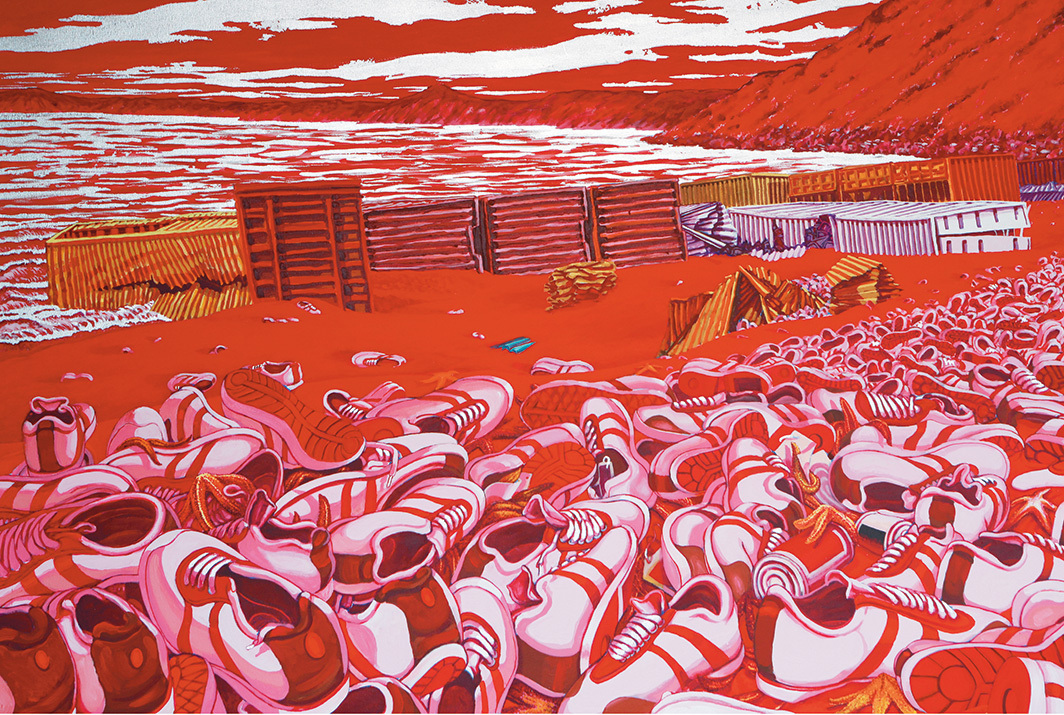Artforum: Dewey Crumpler, Richmond Art Center
Link: https://www.artforum.com/print/reviews/202207/dewey-crumpler-88933
Pdf: https://richmondartcenter.org/wp-content/uploads/2022/09/Artforum-Dewey-Crumpler-Review.pdf
Dewey Crumpler has long been preoccupied with the ways in which objects can be sites of exploration for what it means to be African American. One day in the mid-1990s, while out on his daily walk, he was transfixed by a tower of colorful steel shipping containers stacked at the Port of Oakland in California. To him, the looming rectangular structures were mysterious and foreboding. He saw them as monumental metaphors of the geopolitical power that moved goods across space and time, possessing the history of commerce and oppression in their hidden cavernous interiors. Compelled by a fascination with this form and its shadow, he began to sketch and paint the crates daily. “Dewey Crumpler: Crossings,” his exhibition here, showcased 122 of these prophetic images, which he began making roughly twenty-five years before the collapse of the shipping industry brought on by the pandemic. Vibrant dreamscapes were weighted with the gravitas of their subject matter: mass migration, globalization, and the tangled yoke of capitalism within the Black diaspora.
When Crumpler started as a young artist in San Francisco in the 1960s, he couldn’t find any art in the museums that portrayed Black life. As a result, he sought inspiration from an eclectic array of sources, among them European art, coffee-table books on African American art and culture, the work of social-realist muralist David Alfaro Siqueiros (which he got to see in person during a trip to Mexico), and the improvisational sounds of jazz greats including John Coltrane and Miles Davis. By establishing a practice that focused on a specific object for an extended period, Crumpler was able to ground the panoply of influences he brought to each body of work.
The artist has said that he is drawn to an object because of its capacity to create a shadow, an element that is continuously affected by light and time—i.e., the thing and its shape-shifting companion serve as a jumping-off point. After a trip to Amsterdam in the early 1990s, he created a series of tulip paintings and dioramas that investigated the power of beauty, trade, Blackness, and genetic manipulation. A few years later, he used his son’s discarded hoodie as a subject for a number of cartoonish caricatures and videos, adapting it as a metaphor that delved into Black Futurism and cultural narratives of marginality. Like the tulips and hoodies, the container paintings are conduits for unraveling patterns of empires and capital.
In Crumpler’s renderings, each vessel is a locus of awe, wonder, and terror. Ranging in size from small sketches to large-scale paintings executed in saturated acrylic hues, the works depict wrecked cargo ships overflowing with the colorful bounty of plunder and trade. In a pen-and-ink sketch, Untitled (Crash), 2014, a cascade of crates topples, domino style, off a dock. In Collapse, 2017, more than forty containers sink into a raging turquoise sea. Shimmering gold leaf surrounds them, a nod to the practice (and utility) of employing glitz as a distraction from the darkness that is too often concealed within the politics of trade negotiations. Crumpler’s receptacles are vehicles that not only transport actual goods, but also represent the positive spread of art, culture, and religion wrought, ironically enough, by capitalism. In Untitled 2, 2018, marooned and shattered boxes pour forth their contents—including a phalanx of shell-pink tennis shoes washed up onto a poppy-red shore, calling to mind a herd of sea creatures, bloodied and dead. In Green Bananas, 2017, a beached cargo carrier offers up a giant spill of the titular fruits. Yet hidden among them is Duchamp’s Fountain, 1917. Crumpler has painted the urinal before; its rounded shape recalls the form of a hoodie. Yet here the placement of the porcelain toilet protruding from a pile of green banana skins represents both an homage to one of avant-garde art’s most legendary innovations—the readymade—and a comment on transcultural diffusion.
Similar to a container, a painting is a vehicle that delivers information as it forges new relationships—Crumpler’s “vessels” do this while encapsulating codependent histories of destruction and creation. In Bright Moments and Bitches Brewing in Space, both 2020, the stacked rectangles have been reduced to their most elementary forms: steel bands. Here, the artist’s grids look more like jail bars than like Mondrian’s pure abstract compositions, to which they also allude. Yet, in these more recent works, shadows dance in syncopated rhythms across the surface, reminding us that art, like commerce, has the power to alter the world.
Image: Dewey Crumpler, Untitled 2, 2018, acrylic and mixed media on canvas, 60 × 74″.

